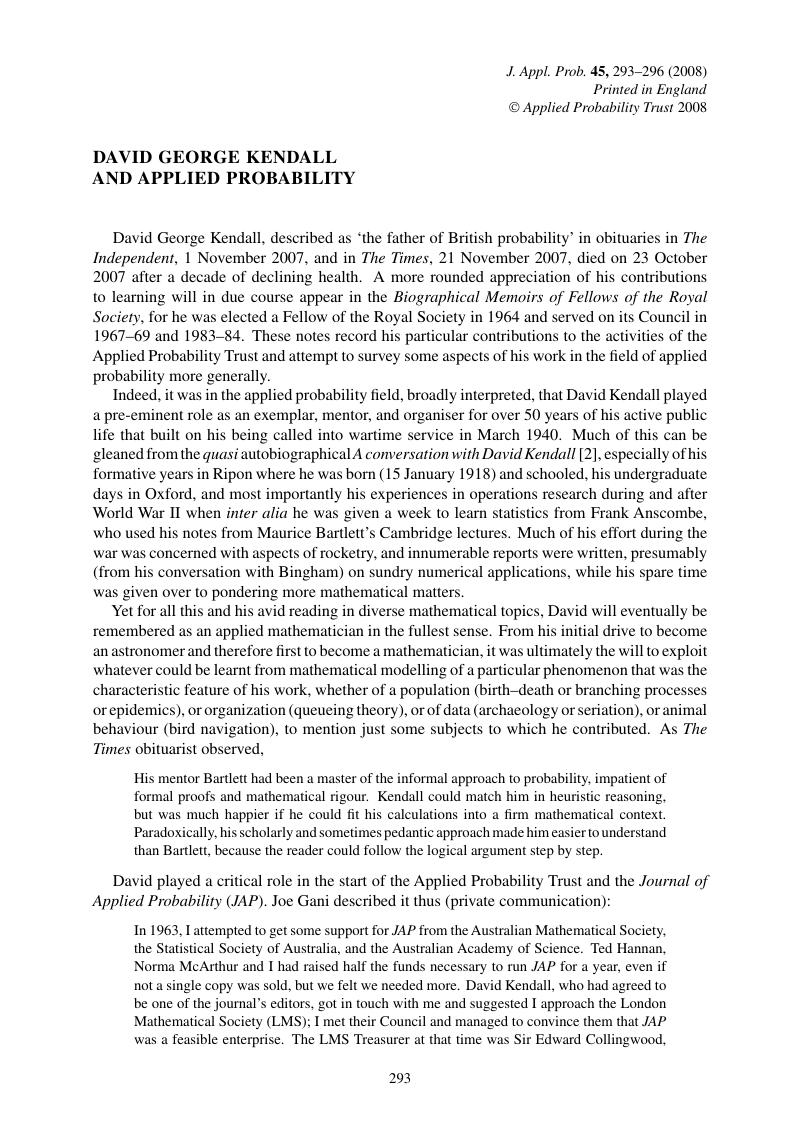No CrossRef data available.
Article contents
David George Kendall and Applied Probability
Published online by Cambridge University Press: 14 July 2016
Abstract
An abstract is not available for this content so a preview has been provided. As you have access to this content, a full PDF is available via the ‘Save PDF’ action button.

- Type
- Obituary
- Information
- Copyright
- Copyright © Applied Probability Trust 2008
References
[1]
Bartlett, M. S. and Kendall, D. G. (1951). On the use of the characteristic functional in the analysis of some stochastic processes occurring in physics and biology. Proc. Camb. Philos. Soc.
47, 65–76.CrossRefGoogle Scholar
[2]
Bingham, N. H. (1996). A conversation with David Kendall. Statist. Sci.
11, 159–188.CrossRefGoogle Scholar
[3]
Feller, W. (1949). Fluctuation theory of recurrent events. Trans. Amer. Math. Soc.
67, 98–119.CrossRefGoogle Scholar
[4]
Kendall, D. G. (1948). On the generalized ‘birth-and-death’ process. Ann. Math. Statist.
19, 1–15.CrossRefGoogle Scholar
[5]
Kendall, D. G. (1949). Stochastic processes and population growth. J. R. Statist. Soc. Ser. B
11, 230–264.Google Scholar
[6]
Kendall, D. G. (1951). Some problems in the theory of queues. J. R. Statist. Soc. Ser. B
13, 151–173; discussion 173–185.Google Scholar
[7]
Kendall, D. G. (1953). Stochastic processes occurring in the theory of queues and their analysis by the method of the imbedded Markov chain. Ann. Math. Statist.
24, 338–354.CrossRefGoogle Scholar
[8]
Kendall, D. G. (1956). Deterministic and stochastic epidemics in closed populations. In Proc. Third Berkeley Symp. Math. Statist. Prob., 1954–1955, Vol. IV, University of California Press, pp. 149–165.Google Scholar
[9]
Kendall, D. G. (1957). La propagation d'une épidémie ou d'un bruit dans une population limitée. Publ. Inst. Statist. Univ. Paris
6, 307–311.Google Scholar
[10]
Kendall, D. G. (1964). Some recent work and further problems in the theory of queues. Teor. Veroyat. Primen.
9, 3–15.Google Scholar
[11]
Kendall, D. G. (1965). Mathematical models for the spread of infection. In Mathematics and Computer Science in Biology and Medicine, HMSO, London, pp. 213–225.Google Scholar
[12]
Kendall, D. G. (1966). Branching processes since 1873. J. London Math. Soc.
41, 386–406.Google Scholar
[13]
Kendall, D. G. (1966). On super-critical branching processes with a positive chance of extinction. In Research Papers in Statistics (Festschrift J. Neyman), John Wiley, London, pp. 157–165.Google Scholar
[14]
Kendall, D. G. (1974). An introduction to stochastic analysis. In Stochastic Analysis, eds Kendall, D. G. and Harding, E. J., John Wiley, London, pp. 3–43.Google Scholar
[15]
Kendall, D. G. (1974). An introduction to stochastic geometry. In Stochastic Geometry, eds Harding, E. J. and Kendall, D. G., John Wiley, London, pp. 3–9.Google Scholar
[16]
Kendall, D. G. (ed.) (1986). Analytic and Geometric Stochastics (Papers in honour of G. E. H. Reuter). Special supplement to
Adv. Appl. Prob.
19.
Google Scholar
[17]
Kendall, D. G. (1988). Applied probability—past, present and future. In A Celebration of Applied Probability (J. Appl. Prob. 25A), ed. Gani, J., Applied Probability Trust, Sheffield, pp. 25–30.Google Scholar
[18]
Kendall, D. G. (1990). Speech proposing the toast to John Hammersley – 1 October 1987. In Disorder in Physical Systems: A Volume in Honour of John M. Hammersley on the Occasion of His 70th Birthday, eds Grimmett, G. R. and Welsh, D. J. A., Oxford University Press, pp. 1–3.Google Scholar
[19]
Kendall, D. G. and Kendall, W. S. (1980). Alignments in two-dimensional random sets of points. Adv. Appl. Prob.
12, 380–424.CrossRefGoogle Scholar
[20]
Kendall, D. G., Barden, D., Carne, T. K. and Le, H. (1999). Shape and Shape Theory. John Wiley, Chichester.CrossRefGoogle Scholar
[21]
Kingman, J. F. C. and Reuter, G. E. H. (eds) (1983). Probability, Statistics and Analysis (London Math. Soc. Lecture Notes 79). Cambridge University Press.CrossRefGoogle Scholar
[22]
Whittle, P. (1983). Competition and bottle-necks. In Probability, Statistics and Analysis (London Math. Soc. Lecture Notes 79), eds Kingman, J. F. C. and Reuter, G. E. H., Cambridge University Press, pp. 277–284.CrossRefGoogle Scholar


